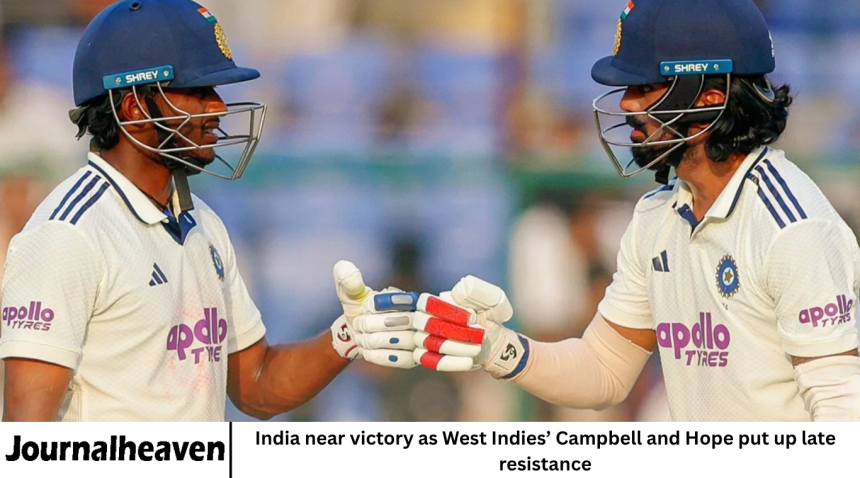India stands on the brink of victory after a dominant performance against the West Indies, though a determined stand by openers John Campbell and Shai Hope has added late drama to the contest. The pair resisted India’s relentless bowling attack with skill and patience, keeping the match alive longer than many expected. Despite their efforts, the visitors remain under heavy pressure, with India’s bowlers just a few wickets away from sealing the result.
India’s Commanding Position
From the start of the match, India took control with both bat and ball. Their top order delivered strong performances, building a commanding lead that set the tone for the rest of the game. The bowlers then followed with precision, using pace, spin, and disciplined line to dismantle the West Indies batting lineup in the first innings.
Rohit Sharma’s captaincy played a key role in maintaining the intensity throughout. India’s field placements, rotation of bowlers, and aggressive mindset reflected a team fully focused on securing victory. With key contributions from players like Jasprit Bumrah, Ravindra Jadeja, and Mohammed Siraj, India’s dominance was never in doubt — until Campbell and Hope stepped up in the final session.
Campbell and Hope’s Steadfast Partnership
When the West Indies began their second innings facing a massive deficit, few expected resistance. But John Campbell and Shai Hope showed determination that revived the spirit of their side. The duo shared a gritty partnership that frustrated the Indian bowlers and briefly shifted the momentum.
Campbell, known for his attacking style, played a more measured innings, choosing to defend skillfully against Bumrah and Siraj’s pace. Hope, ever the composed technician, countered spin effectively, especially against Jadeja and Ashwin. Their partnership didn’t change the match outcome but showed the grit West Indies fans had been waiting for.
For several overs, the Indian bowlers struggled to find breakthroughs. Boundaries were rare, but Campbell and Hope focused on survival, leaving deliveries outside off-stump and rotating strike when possible. Their stand was a small but significant victory in a match dominated by India.
India’s Bowlers Maintain Pressure
Despite the late fightback, India’s bowling attack continued to dominate overall. Jasprit Bumrah’s ability to swing the ball both ways kept the batsmen guessing, while Mohammed Siraj maintained relentless accuracy. Ravindra Jadeja extracted sharp turn and bounce, troubling the middle order when he returned for his second spell.
Ravichandran Ashwin, meanwhile, provided crucial control through the middle overs. His variations in flight and pace limited scoring opportunities, forcing the West Indies batsmen into defensive play. Even as Campbell and Hope built their partnership, India never lost focus. The fielders remained alert, and the bowlers stuck to their plans patiently.
The breakthrough eventually came from Siraj, who induced an edge from Campbell after a long battle. It opened the door for India’s spinners to press further, setting the stage for what seemed an inevitable result.
The Difference in Team Approaches
A major talking point throughout the match has been the difference in discipline and intent between the two sides. India’s batsmen showed maturity, constructing partnerships and building an innings with patience. The West Indies, in contrast, struggled with consistency. Loose shots, poor shot selection, and lack of temperament cost them crucial wickets in both innings.
India’s success is also a result of their adaptability. Whether facing swing early on or spin later, they handled the changing conditions better. The West Indies bowlers, while showing flashes of skill, couldn’t sustain pressure over long periods. Their spinners struggled to extract the same level of control that Jadeja and Ashwin managed effortlessly.
This contrast in execution has been the defining factor in the match, underlining India’s superior preparation and tactical sharpness.
Rohit Sharma’s Leadership and Tactical Edge
Rohit Sharma’s calm yet assertive leadership continues to be a strength for India. Throughout the match, his bowling changes, field placements, and encouragement of younger players stood out. He rotated the bowlers smartly, using Jadeja and Ashwin at the right moments and ensuring the fast bowlers stayed fresh.
Rohit’s decision to enforce pressure through attacking fields — even when Campbell and Hope resisted — reflected his belief in his bowlers. His ability to read the game situation and adjust strategies quickly kept India on top.
Under his captaincy, India has developed a balanced and confident approach, blending aggression with control. This match was another example of how his leadership keeps the team composed even when opponents push back.
West Indies’ Lessons and Positives
While defeat seems likely, the West Indies can take positives from their batting resistance and moments of individual brilliance. Shai Hope’s steady presence under pressure and Campbell’s willingness to adapt his natural game showed a renewed sense of responsibility.
The team’s younger bowlers also gained valuable experience bowling against one of the world’s strongest batting lineups. Despite the result, these lessons will serve as important building blocks as the West Indies continue their rebuilding process.
Head coach Daren Sammy has emphasized consistency and discipline as key priorities. The team’s flashes of fight in this match — especially through Hope and Campbell — suggest progress in mindset, if not yet in results.
India’s Path Forward
For India, this victory (once sealed) will further strengthen their position in the current series and boost confidence ahead of future matches. The performances of their bowlers reaffirm India’s depth and balance across formats.
Emerging talents like Shubman Gill and Yashasvi Jaiswal continue to show promise, while veterans like Virat Kohli and Rohit Sharma maintain stability at the top. In the bowling department, Bumrah’s return to full rhythm and Jadeja’s consistency underline why India remains a world-class side.
The focus will soon shift to upcoming fixtures, but for now, this match stands as another testament to India’s dominance, strategic clarity, and team unity.
The Match in Perspective
This game encapsulates much of what makes Test cricket so fascinating — momentum shifts, moments of resistance, and the mental battle between bat and ball. Campbell and Hope’s stand reminded fans that resilience still matters, even when the odds are stacked.
For India, this near-victory showcases their maturity and ability to maintain pressure across long stretches. It’s also a reminder that great teams not only win but learn from every session — something India’s players have mastered under Rohit Sharma’s calm direction.
In the broader picture, matches like these highlight the importance of patience, skill, and adaptability in modern cricket. While the West Indies fought admirably late in the day, India’s superior consistency has once again made the difference.
Frequently Asked Questions
What was the main highlight of the match?
The late partnership between John Campbell and Shai Hope stood out, offering resistance as India closed in on victory.
How did India dominate the match?
India excelled with both bat and ball, building a massive first-innings lead and applying constant bowling pressure on the West Indies.
Who were India’s standout performers?
Jasprit Bumrah and Ravindra Jadeja impressed with the ball, while the top-order batsmen built strong partnerships early on.
How did Campbell and Hope perform?
Both played patiently, showing determination against India’s world-class attack and delaying what seemed an inevitable defeat.
What lessons can the West Indies take from this match?
They can focus on building consistency, improving shot selection, and maintaining composure under pressure.
How did Rohit Sharma’s captaincy influence the result?
His tactical decisions, effective bowling changes, and calm leadership ensured India remained in control throughout.
What’s next for both teams?
India will look to carry their momentum into upcoming matches, while the West Indies aim to regroup and strengthen their batting approach.
Conclusion
India’s near victory against the West Indies is another statement of their strength and discipline in Test cricket. While Campbell and Hope’s partnership provided resistance and pride for the visitors, it was not enough to alter the inevitable outcome.
This match demonstrated India’s balance, leadership, and tactical precision, with every player contributing to the team’s success. For the West Indies, the lessons learned could spark progress in the long run. But for now, the scoreboard reflects India’s dominance — built on teamwork, resilience, and skill.
As the final day approaches, India’s bowlers are just a few wickets away from confirming another well-earned triumph.








